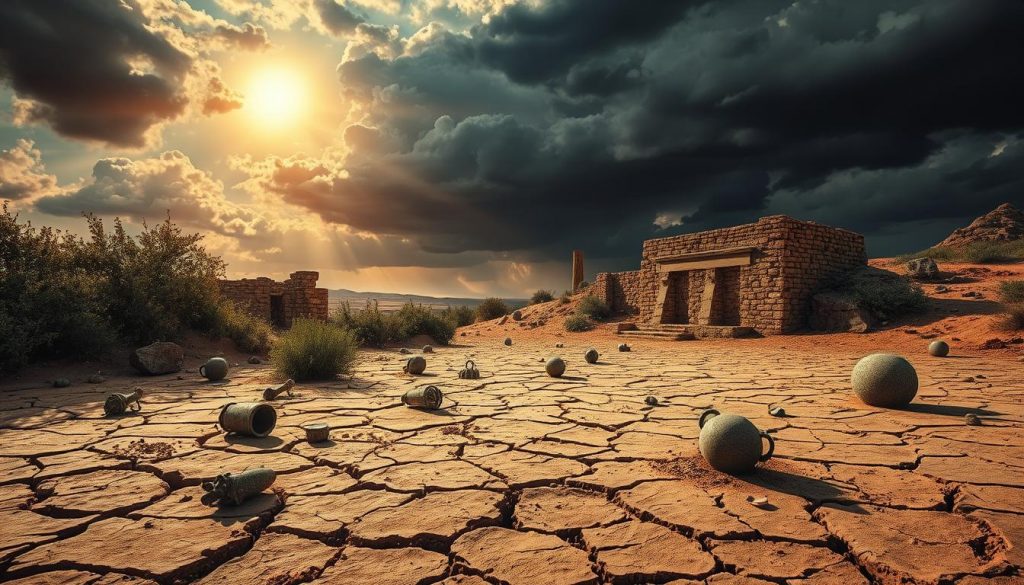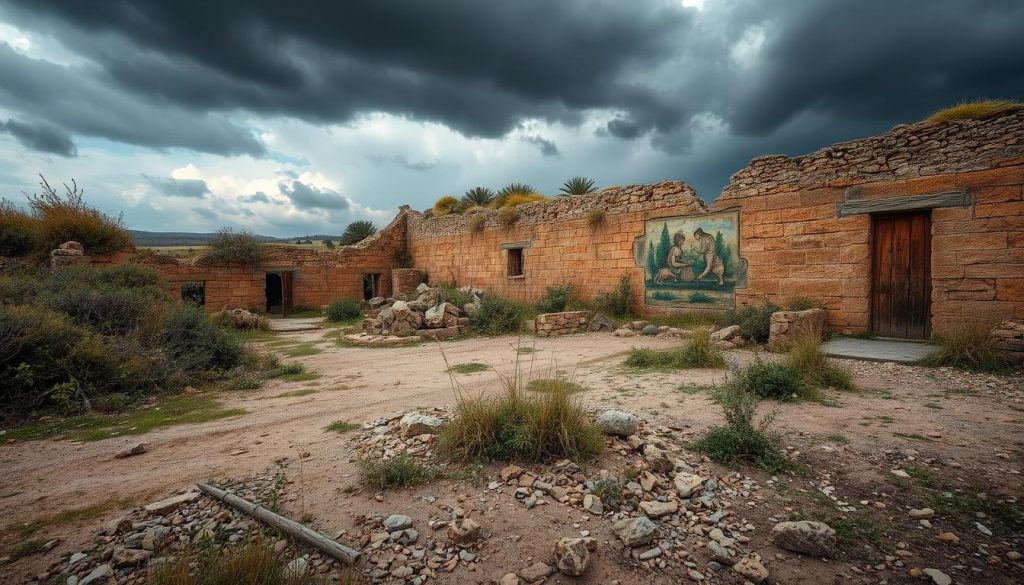The Bronze Age Collapse: A Forgotten Catastrophe
The Bronze Age Collapse happened around 1200 B.C. It was a time when many ancient civilizations, like the Egyptians, Hittites, and Mycenaeans, suddenly declined. This event took place over 3,200 years, affecting a huge area from Italy to Afghanistan.
Anúncios
These cultures were once connected and traded a lot. But then, disasters like invasions by the Sea Peoples and harsh climate changes hit. Economic troubles also played a big role.
This disaster changed the course of history for these ancient societies. It led to big changes in their cultures and ways of life. These changes would be felt for a long time.
Understanding the Bronze Age
The Bronze Age lasted from about 3000 B.C. to 1200 B.C. It was a time of great change and the rise of strong kingdoms. Civilizations like Egypt, Babylonia, and the Indus Valley grew by building complex societies and grand buildings. They also started writing down their stories, helping us learn more about them.
During this time, trade networks connected places from Italy to Afghanistan. The Uluburun shipwreck, from around 1300 BCE, shows how wide these trade paths were. It carried a lot of copper and tin, key for making bronze.
Anúncios
The ship also had a lot of raw glass from Mesopotamia. It had ebony logs from Nubia and jars from Canaan with fruits like grapes. These items show how different cultures traded and interacted.
This trading helped cultures share ideas but also made them more vulnerable. The societies were divided into strict classes, with the elite controlling trade and power. As trade grew, so did the risks of these bronze age civilizations falling apart.
To learn more about why these civilizations declined, check out this source.
The Causes of the Bronze Age Collapse
The Bronze Age collapse was caused by many factors. These factors led to a decline from around 1200 to 1150 B.C. Major cities fell, and civilizations crumbled under pressure from various stresses. Invasions, like those by the Sea Peoples, disrupted trade networks and caused violence across the Mediterranean.
Evidence from Egyptian texts shows the Sea Peoples’ destructive power. They undermined established societies.
There was also a significant economic decline. This was due to over-reliance on fragile trade systems. Resources like bronze needed tin imports from far-off places like England, Spain, and Afghanistan. Copper came mainly from Cyprus.
As trade became more dangerous, resource scarcity caused widespread disruptions.
Archaeological findings also show a climate change. This change likely led to agricultural failures. A decrease in rainfall caused droughts, straining food resources and possibly triggering famines.
The environmental shifts disrupted societal structures. They also intensified unrest, leading to migrations. These migrations further impacted trade and resources.
In conclusion, invasions, economic instability, and environmental changes led to the collapse of Bronze Age civilizations. Understanding these causes shows the vulnerabilities of interconnected societies back then.
The Role of Climate Change
Recent studies show how climate change played a big role in the Bronze Age Collapse. A long drought, called “megadrought,” lasted about 150 to 300 years, starting around 1250 B.C. This dry spell made farming hard across the area.

The Hittite Empire, a powerful force from 1650 to 1200 B.C., faced a severe drought in 1198 B.C. Tree-ring analysis shows this was one of the driest times in over six centuries. This led to years of not enough rain, causing food shortages and famine.
These dry conditions likely led to the Hittites’ downfall. Historical records link these climate changes to their decline.
- The impact on agriculture was profound, as the reliance on water-intensive crops did not align with the drier conditions.
- Societies faced intensified competition for dwindling resources, driving migration toward more hospitable areas.
- Drought conditions heightened vulnerabilities, as many communities persistently struggled with food security.
As vegetation patterns changed, ancient people had to find new ways to survive. But these strategies were not enough. The stress of climate change and environmental factors weakened the farming base of these civilizations. This led to their downfall.
In today’s world, we see similar effects of climate change. It threatens our food stability and can cause social unrest.
Societal Impact of the Bronze Age Collapse
The Bronze Age Collapse happened around 1200 BC. It changed the ancient world a lot. Cities like Troy, Knossos, and Ugarit were destroyed. This led to a big cultural decline.
The way people lived and organized themselves changed a lot. Many places lost their ability to read and write. This was because big governments disappeared.
Before, societies were big and complex. But after the collapse, they broke into smaller villages. These villages were far apart and had their own governments. This change was huge for culture and economy.
Many people moved because of hunger and war. This made things even harder for these new villages.
The collapse also meant less art and building. The Bronze Age was known for its great art and buildings. But after, things changed a lot.
Writing, which helped governments and keep records, started to disappear. This showed how big the impact was.
But from the ruins, new cultures started to grow. The Philistines, for example, became a new group. They mixed with other cultures and formed their own city-states.
This showed that even in tough times, people can adapt and survive. The loss of literacy and cultural decline were big challenges. But they also showed how civilizations can change and grow.
Notable Events During the Collapse
The Bronze Age Collapse was a time of great turmoil. It saw the quick fall of many civilizations. The sea peoples invasions were a key factor in this chaos. Egyptian texts show battles in 1207 B.C. and 1177 B.C., showing the strength of these states was tested.
Archaeology reveals cities were destroyed over a wide area, about 1,000 kilometers. Places like Hattusa and Ugarit were completely destroyed. They were never rebuilt, showing the scale of the destruction.
This time was not just about war. It also saw the end of cultures and economies. In just decades, kingdoms like the Minoans and Mycenaeans disappeared. The trade networks across the Mediterranean broke down, leaving a gap for centuries. The collapse changed the way societies were organized, leading to a loss of knowledge and skills.
To learn more about the impact of these events, check out the effects of this era.
The Aftermath of the Bronze Age Collapse
The bronze age collapse led to a time of great change and instability. Around 1200 BC, many cultures were in trouble. The Mycenaeans and Hittites almost disappeared, but the Assyrians and Babylonians managed to stay strong.
This strength was key in the move to the iron age. New iron tools and weapons changed societies. They helped some areas bounce back quickly by creating new governments and trade routes.
The recovery times varied among cultures, showing different ways to adapt. Some kept their traditions alive, while others changed a lot. This change affected how they ruled and lived together.

Being ready and flexible was crucial for survival. The Assyrian Empire grew strong after the collapse, unlike the Hittites. These changes set the stage for the classical civilizations that came later. They show how important it is to adapt and be resilient after big events.
Archaeological Evidence of the Collapse
Archaeological evidence is key to understanding the Bronze Age collapse. Excavations in the Eastern Mediterranean have uncovered a lot of data. Major bronze age cities’ ruins give us insights into their societies.
At places like Ugarit and Hattusa, we see signs of conflict and decline. Burned buildings and empty streets show the chaos these cities faced. But, some think these stories might be too extreme.
Studies show that climate and politics played big roles. Droughts hurt farming, putting pressure on societies. As we dig deeper, we learn more about the collapse’s complex causes.
| Factors Contributing to Collapse | Evidence Gathered |
|---|---|
| Climatic Changes | Growth rings from juniper trees indicating extended droughts |
| Urban Destruction | Burning and abandonment layers in excavated sites |
| Trade Decline | Evidence of economic stagnation and decreased international trade |
| Conflict and Migration | Archaeological traces of the Sea Peoples’ activities in the region |
The findings from these digs tell us a lot about the Bronze Age collapse. They also raise big questions about how people deal with environmental and social stress. As we keep digging, we’ll learn even more about this important time.
Reevaluating the Bronze Age Collapse
Recent studies have changed how we see the Bronze Age collapse. Instead of one big disaster, scholars now think of it as many small problems. This new view shows that not all places were hit the same way. It makes us rethink how societies survived and adapted back then.
About 90% of cities in the Eastern Mediterranean saw a drop or were abandoned. The Hittite Empire lost half its people. Many sites from that time show signs of being destroyed or left quickly. Yet, some places were very strong and didn’t fall apart.
The way Bronze Age societies were connected is key to understanding this change. Trade networks dropped by 80%, hurting the economy. Farming fell by 50% because of bad weather and a long drought. These facts make us question old ideas and show the need to look at each place’s story.
Looking at how different places were affected helps us learn more. Places like Mycenae and Troy lost over 70% of their people. This shows that not everything was the same. New research gives us a clearer picture of what happened during the Bronze Age collapse.
| Statistical Data | Impact |
|---|---|
| Decline of urban centers | 90% experienced decline or abandonment |
| Population of Hittite Empire | 50% decrease from pre-collapse numbers |
| Archaeological sites with destruction signs | 75% exhibit destruction or sudden abandonment |
| Reduction in trade networks | 80% decline, affecting economic stability |
| Agricultural production decline | Approx. 50% decrease due to climate shifts |
| Duration of the collapse | Lasted roughly over a century (1250-1150 BCE) |
| Population density drop in key areas | Over 70% decline in Mycenae and Troy |
| Significant states or cultures collapsed | Estimated 30 |
Conclusion
The Bronze Age Collapse was a major event around 1200 BC. It led to the fall of many important civilizations in the eastern Mediterranean. Scholars like Arnold Hermann Ludwig Heeren linked it to events like the fall of Troy around 1190 BC.
With 148 archaeological sites showing destruction, this period’s historical significance is clear. It shows how societies are connected and how fragile these networks can be.
The collapse was caused by many factors, including environmental changes and societal pressures. Historians say we can learn from this time. It teaches us about resilience and adapting to crises.
The fall of cities like Hattusa and Ugarit shows how civilizations can change quickly. This teaches us about the rise and fall of societies.
Looking back at the Bronze Age Collapse, it reminds us of the importance of sustainable practices. It warns us of the dangers of ignoring these lessons. Egypt, the only major power left, shows us the challenges societies face.
The stories of this time are not just about destruction. They are guides for survival in our world today.
